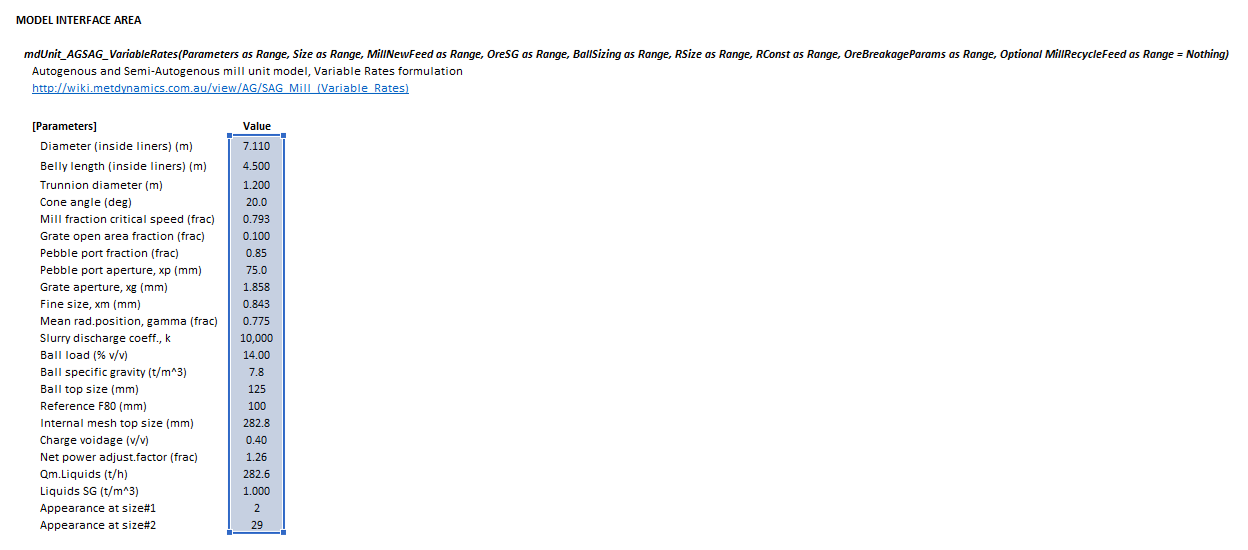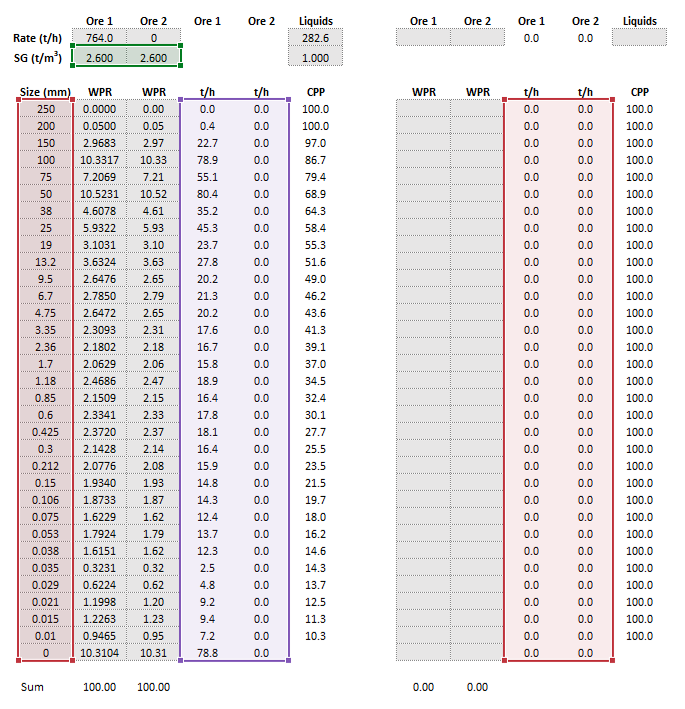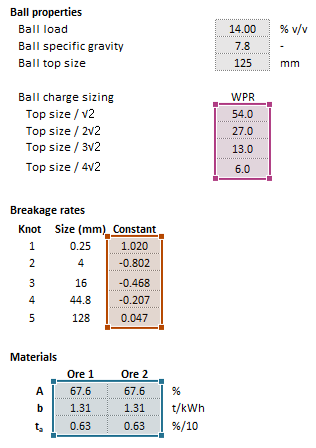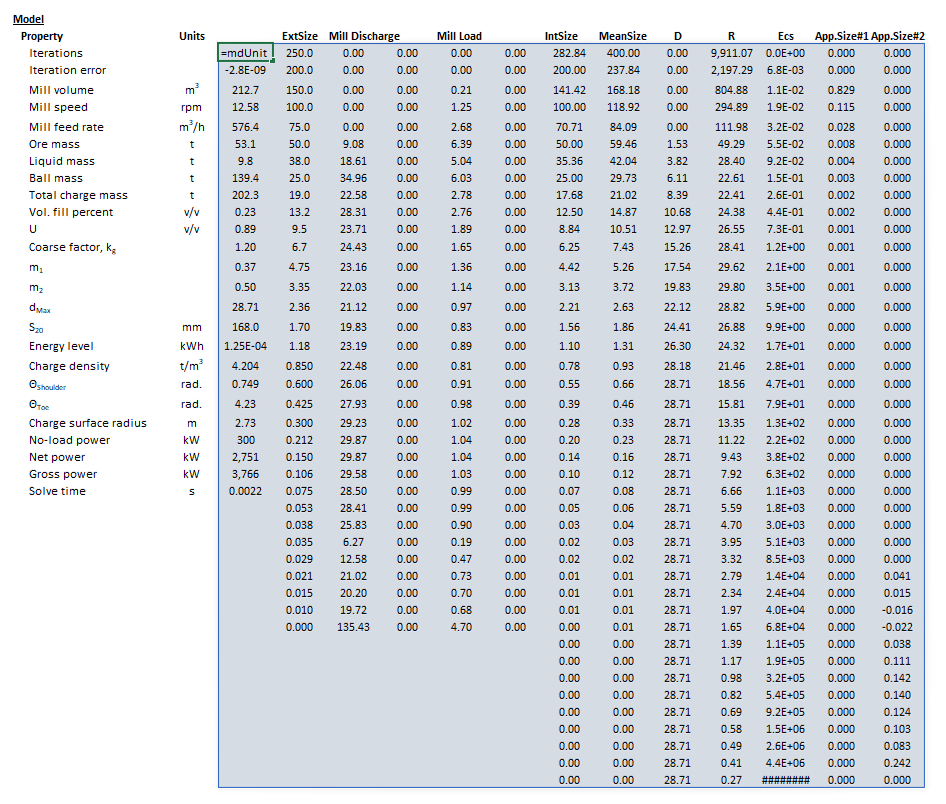AG/SAG Mill (Variable Rates): Difference between revisions
Scott Munro (talk | contribs) m (1 revision imported) |
imported>Scott.Munro m (→Mill page) |
||
| Line 427: | Line 427: | ||
|Spline knot size positions. | |Spline knot size positions. | ||
|- | |- | ||
| | | RConst | ||
|Input | |Input | ||
|Values of <math> | |Values of <math>RConst</math> at each spline knot position. | ||
|- | |- | ||
! colspan="3" style="text-align:left;" |''Other'' | ! colspan="3" style="text-align:left;" |''Other'' | ||
Revision as of 02:47, 9 June 2023
Description
This article describes an implementation of the Autogenous (AG) and Semi-Autogenous (SAG) mill model originated by Leung (1987) and extended with variable breakage rates by Morrell and Morrison (1996).[1][2][3]
The formulation is referred to in the associated literature as the "Variable Rates" model (Morrell et al., 2001).[4]
Model theory
Excel
The Variable Rates AG/SAG mill model may be invoked from the Excel formula bar with the following function call:
=mdUnit_AGSAG_VariableRates(Parameters as Range, Size as Range, MillNewFeed as Range, MillRecycleFeed as Range, OreSG as Range, BallSizing as Range, RSize as Range, RConst as Range, OreBreakageParams as Range)
Invoking the function with no arguments will print Help text associated with the model, including a link to this page.
Inputs
The required inputs are defined below in matrix notation with elements corresponding to cells in Excel row () x column () format:
where:
- is the diameter of the mill inside the liners (m)
- is the length of the belly section of the mill (m)
- is diameter of the discharge trunnion (m)
- is angle between the cone end surface and the vertical direction (deg)
- is the fraction critical speed of the mill (frac)
- is the open area fraction of the discharge grate (frac)
- is the pebble port area fraction (frac)
- is the size of the pebble port aperture (mm)
- is the size of the grate aperture (mm)
- is the fine size (mm)
- is the mean radial position of the grate apertures (m/m)
- is the slurry discharge coefficient
- is the ball load volume fraction (v/v)
- is the density or specific gravity of the ball media (t/m3 or -)
- is ball top size (mm)
- is the reference F80 size (mm)
- is the internal mesh top size (mm)
- is the charge void fraction (v/v)
- is the mass flow feed rate of liquids into the mill (t/h)
- is the Specific Gravity or density of liquids in the feed (- or t/m3)
- is an index of the Appearance function to view in the results
- is an index of the Appearance function to view in the results
- is the number of intervals
- is the number of ore types
- is the size of the square mesh interval that feed mass is retained on (mm)
- , i.e. descending size order from top size () to sub mesh ( mm)
- is new feed mass flow rate (t/h)
- is recycle feed mass flow rate (t/h)
- is the density or specific gravity of solids (t/m3 or -)
- is the mass fraction retained of balls (% w/w)
- is the number of breakage rate knots
- is a breakage rate constant
- (%), , and are ore breakage parameters
Results
The results are displayed in Excel as an array corresponding to the matrix notation below:
where:
- is the number of internal computation steps required to converge the load
- is the numerical error of the converged load approximation
- is the flow rate of pulp into the mill (m3/h)
- is the total volume inside the mill, calculated as the sum of a cylinder and two frustums (m3)
- is the rotational rate of the mill (rpm)
- is the mass of ore solids in the mill (t)
- is the mass of liquids in the mill (t)
- is the mass of balls in the mill (t)
- is the total mass of ore, liquids and balls in the mill (t)
- is the charge volume fraction (v/v)
- is the void fill fraction (v/v)
- is the coarse factor (-)
- is a parameter of the Austin mill holdup equation
- is a parameter of the Austin mill holdup equation
- is maximum discharge rate from the mill (h-1)
- is the geometric mean size of the top 20% of the load (mm)
- is the energy level in the mill (kWh)
- is the charge density (t/m3)
- is angular position of the charge shoulder (rad)
- is angular position of the charge toe (rad)
- is the charge surface radius (m)
- is the no-load power of the mill (kW)
- is the net power of the mill (kW)
- is the gross power of the mill (kW)
- is product mass flow rate (t/h)
- is the geometric mean size of the internal mesh series interval that mass is retained on (mm)
- is the discharge rate (h-1)
- is the breakage rate (h-1)
- is specific comminution energy (kWh/t)
- is the Appearance function (frac)
Example
The images below show the selection of input arrays and output results in the Excel interface.
SysCAD
The sections and variable names used in the SysCAD interface are described in detail in the following tables.
MD_Mill page
The first tab page in the access window will have this name.
| Tag (Long/Short) | Input / Display | Description/Calculated Variables/Options |
|---|---|---|
| Tag | Display | This name tag may be modified with the change tag option. |
| Condition | Display | OK if no errors/warnings, otherwise lists errors/warnings. |
| ConditionCount | Display | The current number of errors/warnings. If condition is OK, returns 0. |
| GeneralDescription / GenDesc | Display | This is an automatically generated description for the unit. If the user has entered text in the 'EqpDesc' field on the Info tab (see below), this will be displayed here.
If this field is blank, then SysCAD will display the unit class ID. |
| Requirements | ||
| On | CheckBox | This enables the unit. If this box is not checked, then the material will pass straight through the mill with no change to the size distribution. |
| NumParallelUnits | Input | The number of parallel, identical units to simulate:
|
| Method | Fixed Discharge | The discharge particle size distribution is user defined. Different distributions can be used for different solids. |
| AG/SAG (Variable Rates) | The Variable Rates AG/SAG mill model is used to determine the mill product size distribution. Different parameters can be used for different solids. | |
| Rod Mill (Lynch) | The Lynch rod mill model is used to determine the mill product size distribution. Different parameters can be used for different solids. | |
| Ball (Perfect Mixing) | The Perfect Mixing ball mill model (steady-state or dynamic) is used to determine the mill product size distribution. Different parameters can be used for different solids. | |
| Stirred (Perfect Mixing) | The Perfect Mixing stirred mill model (steady-state or dynamic) is used to determine the mill product size distribution. Different parameters can be used for different solids. | |
| Mill (Herbst-Fuerstenau) | The Herbst-Fuerstenau model is used to determine the mill product size distribution. Different parameters can be used for different solids. | |
| PowerModels | CheckBox | Show alternative mill power model calculations on the Power page. |
| MediaTrajectory | CheckBox | Show mill media rolling, sliding and free flight trajectory computations on the MediaTraj page. |
| MediaStrings | CheckBox | Show media size distributions at recharge equilibrium on the MediaStrings page. |
| Options | ||
| ShowQFeed | CheckBox | QFeed and associated tab pages (eg Sp) will become visible, showing the properties of the combined feed stream. |
| ShowQProd | CheckBox | QProd and associated tab pages (eg Sp) will become visible, showing the properties of the products. |
| SizeForPassingFracCalc | Input | Size fraction for % Passing calculation. The size fraction input here will be shown in the Stream Summary section. |
| FracForPassingSizeCalc | Input | Fraction passing for Size calculation. The fraction input here will be shown in the Stream Summary section. |
| Stream Summary | ||
| MassFlow / Qm | Display | The total mass flow in each stream. |
| SolidMassFlow / SQm | Display | The Solids mass flow in each stream. |
| LiquidMassFlow / LQm | Display | The Liquid mass flow in each stream. |
| VolFlow / Qv | Display | The total Volume flow in each stream. |
| Temperature / T | Display | The Temperature of each stream. |
| Density / Rho | Display | The Density of each stream. |
| SolidFrac / Sf | Display | The Solid Fraction in each stream. |
| LiquidFrac / Lf | Display | The Liquid Fraction in each stream. |
| Passing | Display | The mass fraction passing the user-specified size (in the field SizeForPassingFracCalc) in each stream. |
| Passes | Display | The user-specified (in the field FracForPassesSizeCalc) fraction of material in each stream will pass this size fraction. |
Mill page
The Mill page is used to specify the input parameters for the mill model.
Ore page
This page is used to define the comminution properties of SysCAD species with the size distribution quality in the project.
Results page
This page is used to display the model results.
| Tag (Long/Short) | Input / Display | Description/Calculated Variables/Options |
|---|---|---|
| Results | ||
| Solver | ||
| Iterations | Display | Number of iterations to converge internal load solver. |
| IterationError | Display | Numerical approximation error of internal load solver. |
| Mill Properties | ||
| MillVolume | Display | Internal volume of the mill. |
| MillSpeed | Display | Rotational speed of the mill. |
| MillFeedRate / Feed.SLQv | Display | Volumetric feed rate of pulp into the mill. |
| Mill Contents | ||
| OreMass | Display | Mass of ore (solids with PSD) in the mill. |
| LiquidMass | Display | Mass of liquids in the mill. |
| BallMass | Display | Mass of ball media in the mill. |
| TotalChargeMass | Display | Total mass of ore, liquids and balls in the mill. |
| VolTotalLoad | Display | Volumetric fraction of mill volume of total charge (ore, liquids, balls and void space). |
| Mill Discharge | ||
| m1 | Display | Parameter of the Austin mill holdup relationship. |
| m2 | Display | Parameter of the Austin mill holdup relationship. |
| dMax | Display | Maximum discharge rate of load volume through the grate. |
| Charge Properties | ||
| S20 | Display | Size of the top (largest) 20% of the load. |
| ChargeDensity | Display | Density of the charge. |
| U | Display | Fraction of charge void space filled with slurry. |
| ThetaShoulder | Display | Angular position of the charge shoulder. |
| ThetaTue | Display | Angular position of the charge toe. |
| ChargeSurfaceRadius | Display | Radius of the inner charge surface. |
| Power | ||
| NoLoadPower | Display | No-load power draw of the mill. |
| NetPower | Display | Net power draw of the mill. |
| GrossPower | Display | Gross power draw of the mill. |
RiDi page
This page displays the breakage and discharge rates for each size interval computed by the model.
| Tag (Long/Short) | Input / Display | Description/Calculated Variables/Options |
|---|---|---|
| Rates | ||
| Size | Display | Size of each interval in internal mesh series. |
| MeanSize | Display | Geometric mean size of each interval in internal mesh series. |
| R | Display | Value of breakage rate, , for each size interval, for each ore species. |
| D | Display | Value of discharge rate, , for each size interval. |
| Ecs | Display | Value of the specific comminution energy for each size interval. |
Load page
This page displays information about the balls, solids and liquids that currently comprise the mill load.
| Tag (Long/Short) | Input / Display | Description/Calculated Variables/Options |
|---|---|---|
| Distribution | ||
| Name | Display | Shows the name of the SysCAD Size Distribution (PSD) quality associated with the feed stream. |
| IntervalCount | Display | Shows the number of size intervals in the SysCAD Size Distribution (PSD) quality associated with the feed stream. |
| SpWithPSDCount | Display | Shows the number of species in the feed stream assigned with the SysCAD Size Distribution (PSD) quality. |
| Load | ||
| SolidMass / SMt | Display | The mass of solids with the SysCAD size distribution property currently in the mill. |
| LiquidMass / LMt | Display | The mass of liquids plus solids without the SysCAD size distribution property currently in the mill. |
| BallMass / BMt | Display | The mass of ball media in the mill. |
| Size | Display | Size of each interval in the external mesh series. |
| MeanSize | Display | Geometric mean size of each interval in the external mesh series. |
| Load | Display | The mass of solids with the SysCAD size distribution property currently in the mill, by size and species. |
Power page
This optional page displays the inputs and results for alternative mill power models. The page is only visible if PowerModels is selected on the MetDynamics*Mill page.
| Tag (Long/Short) | Input / Display | Description/Calculated Variables/Options |
|---|---|---|
| Power | ||
| HoggFuerstenau | CheckBox | Shows inputs and results for tumbling mill power calculations using the Hogg and Fuerstenau method. |
| MorrellC | CheckBox | Shows inputs and results for tumbling mill power calculations using the Morrell Continuum method. |
| MorrellE | CheckBox | Shows inputs and results for tumbling mill power calculations using the Morrell Empirical method. |
| MorrellD | CheckBox | Shows inputs and results for tumbling mill power calculations using the Morrell Discrete Shell method. |
| HildenPowell | CheckBox | Shows inputs and results for tumbling mill power calculations using the Hilden and Powell method. |
MediaStrings page
This page displays the inputs and results for grinding mill media string calculations. The page is only visible if MediaStrings is selected on the MetDynamics*Mill page.
MediaTraj page
This page displays the inputs and results for tumbling mill media trajectory calculations. The page is only visible if MediaTrajectory is selected on the MetDynamics*Mill page.
About page
This page is provides product and licensing information about the Met Dynamics Models SysCAD Add-On.
| Tag (Long/Short) | Input / Display | Description/Calculated Variables/Options |
|---|---|---|
| About | ||
| HelpLink | Opens a link to the Installation and Licensing page using the system default web browser. Note: Internet access is required. | |
| Information | Copies Product and License information to the Windows clipboard. | |
| Product | ||
| Name | Display | Met Dynamics software product name |
| Version | Display | Met Dynamics software product version number. |
| BuildDate | Display | Build date and time of the Met Dynamics Models SysCAD Add-On. |
| License | ||
| File | This is used to locate a Met Dynamics software license file. | |
| Location | Display | Type of Met Dynamics software license or file name and path of license file. |
| SiteCode | Display | Unique machine identifier for license authorisation. |
| ReqdAuth | Display | Authorisation level required, MD-SysCAD Full or MD-SysCAD Runtime. |
| Status | Display | License status, LICENSE_OK indicates a valid license, other messages report licensing errors. |
| IssuedTo | Display | Only visible if Met Dynamics license file is used. Name of organisation/seat the license is authorised to. |
| ExpiryDate | Display | Only visible if Met Dynamics license file is used. License expiry date. |
| DaysLeft | Display | Only visible if Met Dynamics license file is used. Days left before the license expires. |
References
- ↑ Napier-Munn, T.J., Morrell, S., Morrison, R.D. and Kojovic, T., 1996. Mineral comminution circuits: their operation and optimisation. Julius Kruttschnitt Mineral Research Centre, Indooroopilly, QLD.
- ↑ Leung, K., Morrison, R.D. and Whiten, W.J., 1987. An Energy Based Ore Specific Model for Autogenous and Semi-autogenous Grinding, Copper 87, Vina del Mar, Vol. 2, pp 71 - 86
- ↑ Morrell, S. and Morrison, R.D., 1996. AG and SAG mill circuit selection and design by simulation. In International Conference on Autogenous and Semiautogenous Grinding Technology (Vol. 2, pp. 769-790).
- ↑ Morrell, S., Valery, W., Banini, G. and Latchireddi, S., 2001. Developments in AG/SAG mill modelling. Proceedings of Autogenous and Semiautogenous Grinding Technology, Vancouver, pp.71-84.












































































